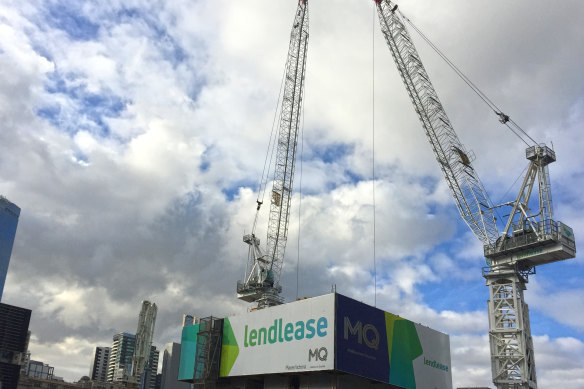
What has happened to upset investors?
Some say the company is too complex, a convoluted, diversified beast split between construction, development and fund management. Within its divisions are vast projects ranging from commercial to residential and infrastructure: Elephant and Castle in London, the $21 billion Google headquarters in San Francisco, and Melbourne Quarter office complex, to name a few.
Complexity is at the heart of key shareholders’ concerns. Veteran investment banker John Wylie, David Di Pilla whose HMC Capital has bumped up its holding to 5.01 per cent, and Allan Gray’s chief investment officer Simon Mawhinney, are leading the charge.
When Lombardo replaced McCann, the business was under pressure. It was the middle of the COVID pandemic. Barangaroo, expecting 28,000 visitors a day, was a ghost town, and work had halted on many Lendlease projects.
At his first official press conference, Lombardo said he planned to simplify the business, reduce skyrocketing costs from the overseas projects, sell the infrastructure business, and focus on growing its investment platform.
His strategy kicked off in August 2021 with 400 jobs cut. He consolidated and simplified Australian operations by merging property and construction, and focusing on Lendlease’s $8 billion development pipeline. Barangaroo was steadily sold down. The jobs cuts added to the 4000 staff who went following the sale of the engineering and services arm.
Fast-forward two years and the company has reported losses and had an investor strike against its remuneration report. It’s been racked by senior staff departures, with US head Denis Hickey – long considered a potential a CEO – leaving along with unlisted funds executive Kylie Rampa.
Lombardo also sold the Lendlease Communities business to Stockland, a sale marked down by analysts as a mistake because it is a profitable business generating long-term revenue. A question mark is also hanging over the Hunter Connection redevelopment in Sydney.
Investors have had enough
Wylie started the revolt with a letter to Lendlease’s board, saying the company’s “flywheel” business model is “fundamentally broken”. Capital allocation is skewed by misplaced targets and lacks appropriate discipline. A radical overhaul of the company and its strategy is imperative – “not just for future success, but for its survival,” the letter reads. “The company is unfocused and overextended with multiple, often-unrelated activities spread across four continents that arguably draw more disadvantages from common ownership than advantages.”
Wylie said a conglomerate business model is only effective if its divisions are successful under independent ownership. “None of your divisions presently make an adequate operating margin or return in investment capital, so the conglomerate structure simply aggregates three underperforming businesses,” he wrote in the letter.
Loading
Former staffers believe the board should be scrutinised for its lack of real estate experts. Others proffer that Lombardo “is out of his depth” and that he and chairman Michael Ullmer are “not compatible”.
Lendlease responded by calling in the cavalry.
Advisers Morgan Stanley, Gresham and Macquarie are running the numbers to determine how the embattled firm can unlock shareholder value.
Euree Asset Management’s Winston Sammut says the proposed direction set out in Tanarra Capital’s letter is “justified given Lendlease’s history”.
“The company has a mix of complicated businesses, domestic and offshore, which investors seem to have difficulty in analysing/tracking, let alone management. Accordingly, some simplification would be welcomed providing much needed support for the share price,” Sammut said.
Di Pilla is less combative than Wylie, and while he supports Lombardo, he is also looking for action.
“Lendlease’s performance has clearly been disappointing, and it is evident that more decisive strategic action needs to be taken,” Di Pilla told the Australian Financial Review. “We believe the initiatives that Lendlease has already articulated are moving in the right direction – namely repatriation of capital back to Australia, scaling back offshore construction, reducing exposure to long-dated projects and ongoing progress on cost efficiencies.”
Mawhinney believes Lendlease could extract up to $4 billion by bailing on its overseas endeavours – particularly the Tun Razak Exchange project in the financial district of Kuala Lumpur, Malaysia.
So what happens next?
Lombardo must calm investor anxiety at the company’s strategy day in May.
“We always welcome feedback from our security holders,” he has so far responded. “Like many listed companies, our register is composed of a broad range of security holders with sometimes differing investment objectives.”

Critics say Lendlease is too complex – a convoluted, diversified beast.Credit: Paul Rovere
Lendlease closed its US central and West Coast construction operations including the landmark $21 billion Google project.
“We’ve simplified the organisational structure and slimmed our management layers, resulting in a sustained reduction to our cost base of $320 million,” Lombardo said. “We also scaled back new development projects to select Australian cities and Singapore, where we have a compelling competitive advantage and with a long track record.”
Nevertheless, the wolves are circling. Unless Lombardo can appease objectors, he, the board, and the business face major upheaval, and time is running out.
The Business Briefing newsletter delivers major stories, exclusive coverage and expert opinion. Sign up to get it every weekday morning.









 Add Category
Add Category